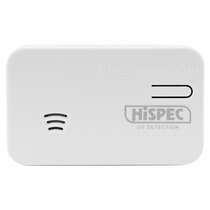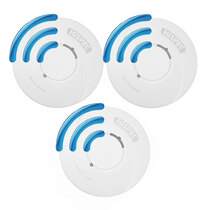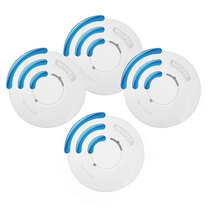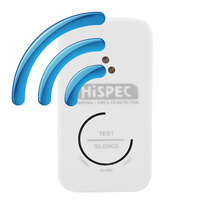-
Contact
Sales & Customer Service
0800 612 6537 support@safelincs.co.uk Live ChatDelivery Enquiries
0800 077 6149 - Resources
Fire & Safety Solutions
CALL OUR TEAM NOW 0800 612 6537
Lines open today 8am - 6pm
FREE Delivery
on marked products
Live Chat - Online
Instant help & Advice
Trade Discounts
and exclusive pricing
0% Credit Available
Open an account now
5 Star Customer Feedback
Alarms Suitable for English Landlord Regulations
From 1st October 2022 in England and Wales, The Smoke and Carbon Monoxide Alarm (Amendment) Regulations 2022 will require all social housing providers and landlords to ensure suitable, working smoke and carbon monoxide (CO) alarms are installed in their properties. This expands the scope of the 2015 landlord regulations which originally excluded social housing and focused on the private rental sector.
The requirements for CO alarms have also been expanded for all landlords, private and social, from just where a solid fuel burning appliance is fitted to include all fixed combustion appliances other than a gas cooker – though gas cookers can still be a source of lethal carbon monoxide, so Safelincs strongly recommends CO alarms be provided for these appliances as well.
Government guidance recommends the use of alarms powered by ‘sealed for life’ models such as those using lithium batteries. To ensure a fire is detected as soon as possible and all occupants are alerted to the danger, interlinked or interconnected alarms such as radio-frequency (RF) battery alarms or hardwired mains alarms talk to each other and all will sound if one detects a possible fire or carbon monoxide leak.
Where guidance overlaps or conflicts, properties in Wales must follow the Renting Homes (Fitness for Human Habitation) (Wales) Regulations 2022 instead.
10 Year Longlife Battery Carbon Monoxide Detector - Hispec HSA/BC/10
- Product Lifespan: 10 years
- Battery: 10 year sealed lithium battery
- Warranty: 5 year warranty
- Suitable for free standing or wall mounting
- Certified to BS EN 50291-1 for home use
- Compliant with Scottish 2022, Welsh Landlord 2022, and Northern Ireland Landlord 2024 legislation
10 Year Longlife Battery Optical Smoke Alarm - Hispec HSABP10
The Hispec 10 year lithium battery operated smoke alarm, has enhanced sensing technology providing continuous protection to detect smoke and give the earliest warning of a potential fire, while minimising false alarms.
- Battery: 10 year sealed lithium battery
- Warranty: 5 year manufacturer's warranty
- Optical smoke sensor suitable for hallways, landings, living rooms, and bedrooms
Radio-Interlinked Smoke Alarms and Heat Alarm Home Essentials Kit - UltraFire UFUB1RFKIT
- Battery powered with AA alkaline batteries
- Warranty: 10 year warranty
- Large test & hush button
- Wirelessly interlink up to 50 UltraFire UB1RF series alarms
- 2 x optical smoke alarms and 1 x heat alarm included
- Suitable for BS 5839-6: 2019 Grade F2 installations
10 Year Longlife Battery Optical Smoke Alarm - UltraFire ULLS10
Powered by a 10 year sealed lithium battery and featuring an optical smoke sensor specially designed to maximise smoke detection and minimise false alarms, this alarm provides top-class standalone protection.
- Battery: 10 year sealed lithium battery
- Warranty: 10 year manufacturer's warranty
- Optical smoke sensor suitable for hallways, landings, living rooms, and bedrooms
10 Year Longlife Battery Heat Alarm - UltraFire ULLH10
Ideal for rooms like garages, kitchens, and lofts where dust or fumes would cause false activations of smoke alarms, the UltraFire ULLH10 features a sealed 10 year battery and 10 year manufacturer's warranty.
- Battery: 10 year sealed lithium battery
- Warranty: 10 year manufacturer's warranty
- Heat sensor suitable for kitchens and garages
10 Year Life Carbon Monoxide Alarm - Kidde K5CO
- Product Life: 10 years
- Battery: 2 x AA batteries included
- Warranty: 7 years
- LED indicators for alarm status
- CE marked and UKCA marked
- Kitemarked to BS EN 50291-1 for domestic use
- Also suitable for the 2022 Welsh legislation
10 Year Life Carbon Monoxide Alarm with Digital Display - Kidde K5DCO
- Product Lifespan: 10 years
- Battery: 2 x AA alkaline batteries (included)
- Warranty: 7 year warranty
- Digital display to show peak level
- Kitemarked to BS EN 50291-1 (domestic use)
- Also suitable for the 2022 Welsh legislation
Carbon Monoxide Alarm 10 Yr Warranty - Kidde K7CO
- Product Life: 10 years
- Battery: 2 x AA alkaline batteries (included)
- Warranty: 10 year warranty
- Green, amber and red LED’s indicate alarm status
- Kitemarked to BS EN50291-1 (domestic use)
- Kitemarked to BS EN50291-2 (caravans / boats)
- Also suitable for the 2022 Welsh legislation
Carbon Monoxide Alarm with Digital Display and 10 Year Warranty - Kidde K7DCO
- Product Life: 10 years
- Battery: 2 x AA batteries included
- Warranty: 10 years
- Digital display from 10ppm CO
- Peak Level Memory – highest CO level recall
- Approved for use in homes, caravans and boats
- CE and UKCA marked, and Kitemarked
- Also suitable for the 2022 Welsh legislation
Battery Smoke Alarms and Heat Alarm Home Essentials Kit - UltraFire UFUB1KIT
- FREE delivery
- Battery: Alkaline batteries (included)
- Warranty: 10 year warranty
- Large test and hush button
- 2 x optical smoke alarms and 1 x heat alarm included
- Suitable for BS 5839-6: 2019 Grade F2 installations
- CE marked
Optical Smoke Alarm with Replaceable 3 Year Alkaline Batteries and Escape Light – FireAngel FA6611-R
- Battery: 2 x AA three year replaceable batteries
- Warranty: 5 year warranty
- Extra bright light to illuminate your escape route
- Suitable for BS5839-6: 2019 Grade F2 installations
- Certified to BS EN 14604: 2005
10 Year Sealed Longlife Battery Operated Carbon Monoxide Alarm - Kidde K10LLCO
- Product Lifespan: 10 years
- Battery: Sealed-in Lithium Battery
- Warranty: 10 year warranty
- Coloured LEDs to indicate alarm, operation and fault
- Kitemarked to BS EN 50291-1: 2018
- Suitable for both the Welsh and Scottish 2022 legislation
- Suitable for new fuel-burning appliances per Building Regs Document J
10 Year Longlife Battery Carbon Monoxide Alarm with Digital Display - Kidde K10LLDCO
- Product Lifespan: 10 years
- Battery: Sealed-in lithium battery
- Warranty: 10 year warranty
- Digital display of CO levels from 11ppm
- Kitemarked to BS EN 50291-1: 2018 for home use
- Compliant with Scottish 2022, Welsh Landlord 2022, and Northern Ireland Landlord 2024 legislation
Radio-Interlinked 10 Year Sealed Battery Heat Alarm - UltraFire ULLH10RF
The UltraFire ULLH10RF features a sealed 10 year battery and wireless interlink with up to 15 total alarms to alert the whole house of a possible fire emergency. Ideal for kitchens, garages, basements, and lofts.
- Battery: 10 year sealed lithium battery
- Warranty: 10 year manufacturer's warranty
- Heat sensor suitable for kitchens and garages
- Wireless interlink up to 15 total alarms
Radio-Interlinked Sealed Battery 2 Smoke and 1 Heat Alarm Kit - Hispec RF10-PRO Range
- Battery: 10 year sealed lithium battery
- Warranty: 5 year warranty
- Radio-interlink up to 20 Hispec RF10-PRO Alarms
- Suitable for BS 5839-6: 2019 Grade F1 installations
- Compatible with the Hispec Control Unit and Carbon Monoxide Alarm
- Also suitable for the 2022 Scottish legislation
Radio-Interlinked Sealed Battery 3 Smoke Alarms and 1 Heat Alarm Kit - Hispec RF10-PRO Range
- Battery: 10 year sealed lithium battery
- Warranty: 5 year warranty
- Wirelessly interlink up to 20 Hispec RF10-PRO devices
- Suitable for BS 5839-6: 2019 Grade F1 installations
- Compatible with the Hispec Control Unit and Carbon Monoxide Alarm
- Also suitable for the 2022 Scottish legislation
10 Year Longlife Battery Wireless Carbon Monoxide Alarm – Hispec RF10-PRO Range
- Battery: 10 year sealed lithium battery
- Warranty: 5 year warranty
- Radio-interlink up to 20 Hispec RF10-PRO Alarms
- CE marked and Kitemarked, suitable for Grade F1 installations
- Compatible with the Hispec Control Unit and Hispec Smoke and Heat Alarms
- Also suitable for both the Welsh and Scottish 2022 legislation
Radio-Interlinked Test / Hush Control Unit for Smoke, Heat & CO Alarms - Hispec RF10-PRO Range
- Power: 10 year sealed lithium battery
- Warranty: 5 years
- Wirelessly control up to 19 Hispec RF10-PRO Alarms
- Alarms sold separately
- RF range up to 80 metres
- Test, locate and silence functions
Mains Powered 2 Smoke Alarms and 1 Heat Alarm Kit with Alkaline Back-up Battery - Kidde Firex KF Series
- Power: 230V mains powered with alkaline back-up battery
- Back-up Battery: 9V alkaline battery (included)
- Warranty: 6 year warranty
- Hardwire interlink with up to 24 devices
- Suitable for BS 5839-6: 2019 Grade D2 installations
- Also suitable for both the Welsh and Scottish 2022 legislation
Mains Powered 2 Smoke Alarms and 1 Heat Alarm Kit with Self-Charging 10 Year Back-up Battery - Kidde Firex KF-R Series
- Power: 230V mains powered with self-charging lithium back-up battery
- Back-up Battery: Self-charging 10 year back-up battery
- Warranty: 6 year warranty
- Hardwire interlink up to 24 compatible devices
- Suitable for BS 5839-6: 2019 Grade D1 installations
- Compliant with Scottish 2022, Welsh Landlord 2022, and Northern Ireland Landlord 2024 legislation
Page 1 (20 of 40 Products)
2022 English Legislation
Alarm Power Requirements
Interlink Compatibility
2022 English Legislation
From 1st October 2022 in England and Wales, The Smoke and Carbon Monoxide Alarm (Amendment) Regulations 2022 will require all social housing providers and landlords to ensure suitable, working smoke and carbon monoxide (CO) alarms are installed in their properties. This expands the scope of the 2015 landlord regulations which originally excluded social housing and focused on the private rental sector.
A general summary of the new requirements are:
- One smoke alarm on each storey where there is a room used as living accommodation.
- One carbon monoxide alarm in any room used as living accommodation which contains a fixed combustion appliance (excluding gas cookers).
- Ensure smoke alarms and carbon monoxide alarms are repaired or replaced once informed and found that they are faulty.
- Alarms must be installed in compliance with British Standards BS 5839-6.
- Where there is a carbon-fuelled appliance (e.g. boiler or gas cooker) or a flue, a carbon monoxide alarm is also required.
- Where battery powered alarms are selected, alarms with 'sealed for life' batteries are recommended.
It is the landlord's duty to ensure a sufficient number of suitable alarms are installed correctly and working at the start of each tenancy. After this, the tenants must perform regular testing and maintenance (including replacing batteries). If an alarm is faulty and replacing the batteries does not rectify the issue, the tenant must inform the landlord who will arrange the repair or replacement of the alarm. However, landlords are recommended to provide a demonstration and instructions to tenants for the testing and maintenance, and must make an informed decision to meet the needs of tenants with special requirements or disabilities.
Alarm Power Requirements
Although the new legislation does not directly state the power source or interlink type required for alarms to be compliant, Government guidance does say that alarms should comply with British Standard BS 5839-6, the Code of Practice for Fire Detection and Alarm Systems in Domestic Premises. BS 5839-6: 2019 also has a table of recommended alarms for different types of domestic premises, with rented properties being advised to install Grade D1 alarms in Category LD2 positions – all circulation spaces that form part of escape routes plus all rooms and areas that present a high fire risk to occupants, such as kitchens and living rooms.
Any mains-powered alarms, regardless of sensor type, must be permanently wired into a mains circuit. Alarms which use a mains plug are not suitable for the updated regulations.
Smoke & Heat Alarm Grades
British Standard 5839 Part 6 is a code of practice relating to the design, installation and maintenance of fire detection systems in domestic premises. The standard also grades fire detection systems which reflects their functionality and capability. The below table details the up-to-date grades for fire detection systems.
Alarm Grades by Power Type (BS 5839 Part 6)
| BS 5839-6: 2019 Grade | Alarm Power Type | Grade Description |
|---|---|---|
| Grade F1 | Battery Operated (Lithium) | System of one or more battery-powered smoke alarms (and heat alarms if required). The battery must be tamper-proof and last the full life of the alarm. |
| Grade F2 | Battery Operated (Alkaline) | System of one or more battery-powered smoke alarms (and heat alarms if required). The battery is user-replaceable and will not last the full life of the alarm. |
| Grade D1 | Mains Powered (Lithium Back-up) | System incorporating one or more interlinked mains-powered smoke alarms (and heat alarms if required), each with an integral stand-by supply. They can be hardwire-interlinked or radio-interlinked. The stand-by supply must be tamper-proof and last the full life of the alarm. |
| Grade D2 | Mains Powered (Alkaline Back-up) | System incorporating one or more interlinked mains-powered smoke alarms (and heat alarms if required), each with an integral stand-by supply. They can be hardwire-interlinked or radio-interlinked. The stand-by supply is user-replaceable and will not last the full life of the alarm. |
| Grade C | Mains Powered (Dedicated Circuit + Back-up) | System consisting of fire detectors and alarm sounders (which may be domestic smoke alarms) connected to a common power supply, comprising normal mains and stand-by supply, with central control equipment. |
| Grade A | Mains Powered (Panel - Built-in PSU + Back-up) | Fire detection system incorporating control and indicating equipment to BS EN 54-2, power supply to BS EN 54-4, and installed to BS 5839 Part 1, with some very minor exceptions. |
For a full summary of BS 5839 Part 6, please visit 'Fire Detection and Fire Alarm Systems for Buildings'.
Interlink Compatibility
Hardwire Interlink
Smoke alarms, heat alarms, and carbon monoxide alarms powered from a mains circuit will usually also have an interlink or interconnect terminal next to the live and neutral wire terminals. If one alarm detects a fire or CO emergency it will pass the signal to the other units which will also sound an alarm throughout the property. This is particularly important for large buildings or if the bedroom is located far away from the kitchen. Outhouses and garages can also be connected into the radio-interlinked alarm system for added peace of mind.
Mains alarms can be connected to nearby lighting circuits for power, provided the light switch does not also turn off power to the alarm, but the interlink wire must be separate and not 'piggy-back' on a mains circuit as smoke, heat, and CO alarms are not designed to take 230V in their interlink terminal. If the property does not already have mains-powered alarms wired in, or if testing one of your existing alarms does not also cause the other alarms to sound, then an electrician will need to install a new interlink cable throughout the building.
Radio-Interlink
Radio-interlinked smoke alarms, heat alarms, and carbon monoxide alarms communicate with each other via radio frequency (RF). If one alarm detects a fire or CO emergency it will pass the signal to the other units which will also sound an alarm throughout the property. This is particularly important for large buildings or if the bedroom is located far away from the kitchen. Outhouses and garages can also be connected into the radio-interlinked alarm system for added peace of mind.
Radio-interlinked alarms are sometimes referred to as wireless alarms, although this can be confusing when dealing with radio-interlinked units wired into the mains power supply in a building. Radio-interlinked alarms can be battery powered or mains powered, and we even offer battery operated smoke alarms, heat alarms, and carbon monoxide alarms with radio-interlink that contain a sealed battery which lasts the full ten years of the alarm's life.
Compatibility
Only interlink alarms with alarms from the same model range and manufacturer. Alarms from different manufacturers are not compatible and attempting to interlink them could damage the alarms. If in doubt, check the instruction manual for the alarms before purchase – we provide PDF instruction manual downloads for the majority of smoke, heat, and CO alarms on our website.
Some ranges support mixing hardwired and radio-interlink alarms in the same network, which can reduce electrician costs and disruption. All alarms on each storey would be connected together via hardwire interlink, with one alarm on each storey also being connected to each other via RF signal. This could also save money on product costs, as mains-powered alarms without radio-interlink are usually the cheapest option for interlinking alarms. Please confirm before purchase if you require this functionality.






































